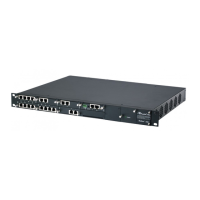Version 6.4 711 March 2012
SIP User's Manual A. Configuration Parameters Reference
Parameter Description
The valid values of this parameter are described below:
[0] = Not supported (default).
[1] = Supports CAS NFA DMS-100 transfer. When a SIP
REFER message is received, the device performs a Blind
Transfer by executing a CAS Wink, waits for an
acknowledged Wink from the remote side, dials the Refer-to
number to the switch, and then releases the call.
Note: A specific NFA CAS table is required.
[2] = Supports ISDN (PRI/BRI) transfer - Release Link Trunk
(RLT) (DMS-100), Two B Channel Transfer (TBCT) (NI2),
Explicit Call Transfer (ECT) (EURO ISDN), and Path
Replacement (QSIG). When a SIP REFER message is
received, the device performs a transfer by sending Facility
messages to the PBX with the necessary information on the
call's legs to be connected. The different ISDN variants use
slightly different methods (using Facility messages) to
perform the transfer.
Notes:
For RLT ISDN transfer, the parameter
SendISDNTransferOnConnect must be set to 1.
The parameter SendISDNTransferOnConnect can be
used to define if the TBCT/ECT transfer is performed
after receipt of Alerting or Connect messages. For RLT,
the transfer is always done after receipt of Connect
(SendISDNTransferOnConnect is set to 1).
This transfer can be performed between B-channels
from different trunks or Trunk Groups, by using the
parameter EnableTransferAcrossTrunkGroups.
The device initiates the ECT process after receiving a
SIP REFER message only for trunks that are configured
to User side.
[3] = Supports CAS Normal transfer. When a SIP REFER
message is received, the device performs a Blind Transfer
by executing a CAS Wink, dialing the Refer-to number to the
switch, and then releasing the call.
[4] = Supports QSIG Single Step transfer (PRI/BRI):
IP-to-Tel: When a SIP REFER message is received, the
device performs a transfer by sending a Facility message to
the PBX, initiating Single Step transfer. Once a success
return result is received, the transfer is completed.
Tel-to-IP: When a Facility message initiating Single Step
transfer is received from the PBX, a SIP REFER message is
sent to the IP side.
[5] = IP-to-Tel Blind Transfer mode supported for ISDN
(PRI/BRI) protocols and implemented according to AT&T
Toll Free Transfer Connect Service (TR 50075) “Courtesy
Transfer-Human-No Data”. When the device receives a SIP
REFER message, it performs a blind transfer by first dialing
the DTMF digits (transfer prefix) defined by the parameter
XferPrefixIP2Tel (configured to "*8" for AT&T service), and
then (after 500 msec) the device dials the DTMF of the
number (referred) from the Refer-To header sip:URI
userpart.
If the hostpart of the Refer-To sip:URI contains the device's
IP address, and if the Trunk Group selected according to the

